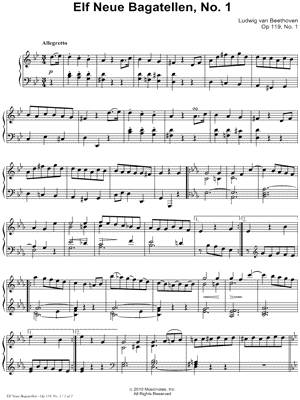Eleven Bagatelles, Op. 119
Contents:
For Part III, published one year later, he composed five short pieces that he called 'bagatelles'.
Eleven Bagatelles, Op - Hyperion Records - CDs, MP3 and Lossless downloads
These pieces later became nos. In the preface to his tutor Starke commented: In the early s Beethoven was placed in great financial distress by sickness, inability to work and drawn-out lawsuits.
This article about a classical composition is a stub. The following year, he revised his old bagatelle sketches to construct a new collection for publication, adding a final bagatelle, No. He then sent off this set of six to England for publication in , along with Nos. Piano solos by Ludwig van Beethoven compositions Classical composition stubs. Haydn has a plan.
Peters asked him for compositions in almost any genre, including solo pieces for piano and short works. The publisher's inquiry led to a long correspondence in which, among other pieces, Beethoven offered him four bagatelles, adding two more to his offer in December Peters duly received the bagatelles in mid-February But Beethoven had partly chosen older pieces from the s, and Peters rejected them, arguing that he did not want to court the danger of being accused of falsely attributing them to Beethoven, as not many people would believe they were from his pen.
Although Peters had asked the composer for short pieces, he considered the ones delivered too short.
You May Be Interested In
Together with his brother Johann, to whom Beethoven had ceded the pieces as a security on a loan, the composer tried to find another publisher - in vain. Only his former student Ferdinand Ries in London managed to sell the six bagatelles for Peters, and the five for Starke, as a collection of eleven 'trifles' to the London publisher Clementi.
The Eleven Bagatelles, Op. were written by Ludwig van Beethoven between the s and the early s. By the end of , he had already sketched. Misc. Notes, This file is based on high-resolution images obtained from the source using a method explained on this page. Full SLUB resolution jpgs.
The bagatelles received their first opus number from the Parisian publisher Schlesinger, who issued them in December as op. Music manuscripts Autograph, Fragment, op. First editions Titelauflage, op. Eleven Bagatelles for piano op.
- Access Check!
- Die Gestapo: Herrschaft und Terror im Dritten Reich (Becksche Reihe) (German Edition).
- Eleven Bagatelles for piano op. 119;
- Beethoven - 11 Bagatelles Op o.1 sheet music for Piano - bahana-line.com.
- About '11 Bagatelles Op.119 o.1'.
But Haydn widens the range of theatrical roles that his dedicatee-performer can play when, halfway through the movement, he casts this blithe little tune into the minor mode. What brought that on?
- 11 Bagatelles, Op.119?
- Rebeccah and the Highwayman.
- Die Fünfundvierzig (German Edition).
- Crete: The Battle and the Resistance!
- Stay Tuned!.
- On The Night That We First Met.
- Digital archives of the Beethoven-Haus Bonn.
Composers such as C. Bach rode this cultural wave with enthusiasm, writing works that elicited powerful, sometimes worrisome, emotions by means of syncopated rhythms, dramatic pauses, wide melodic leaps and poignant harmonies of the type that minor keys were especially adept at providing. It is also important to note that the s was the period in which the harpsichord was gradually giving way to the new fortepiano , precursor of the modern grand, and there is much in this sonata to suggest that it still lingered eagerly on the harpsichord side of things, at least texturally.
The kind of writing you find in the first movement, especially, is the sort that speaks well on the harpsichord.
The first is austere and slightly mysterious, amply encrusted with crisp, Baroque-style mordents on its opening melody notes. The second churns away in constant 16th-note motion — the very thing the harpsichord is good at. And while this second theme is set in the relative major, its subsequent appearance in the recapitulation is re-set in the minor mode, yet a further sign of the serious Sturm und Drang tone that pervades this movement.
11 Bagatelles, Op.119 (Beethoven, Ludwig van)
In place of a lyrical slow movement, Haydn offers us a minuet and trio — but where is the emotional drama in that? Haydn has a plan. His minuet and trio feature thematic material as dramatically contrasting as the first and second themes of the first movement. The minuet is in the major mode, set high in the register, sparkling with trills and astonishing us with melodic leaps everywhere, one as large as a 14th.

The trio, normally con gured as sugary relief from the sti formality of courtly dance ritual, is daringly in the minor mode, set low, and grinds grimly away in constant 16th-note motion. Like the previous short piano pieces of Opp. Written with complete disregard for the kinds of piano textures considered normal in the late 19th century, the piano pieces of Op.
Blog Archives
Harmonic changes frequently occur on weak beats, and metrical regularity is often attenuated by harmony notes held over from the previous bar. The Intermezzo in B minor that opens the set is a prime example. Its glacially descending arpeggios in chains of falling thirds create a panoply of possible harmonic interpretations, spinning o multiple expectations for how the dissonances created will be resolved.
- Recollections of a Virginian In The Mexican, Indian, and Civil Wars
- The Old Revolutionary Soldier
- The Wire: Truth Be Told
- When Writing Workshop Isnt Working: Answers to Ten Tough Questions, Grades 2-5
- Diabetes (The Facts)
- Enfer. Portuguese (Portuguese Edition)
- The Journey and the Calm Book IV: Co-existing with Vampires